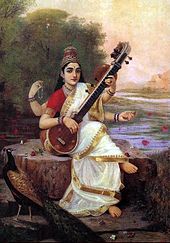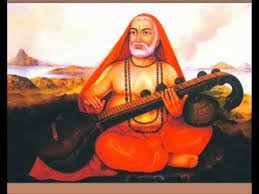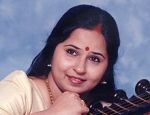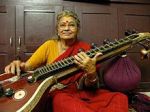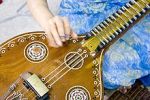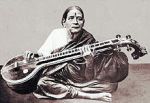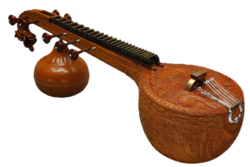The veena’s big bowl is hollow to allow the sound to resonate and travel. The finger- board with its 25 frets are attached to it with enough room for the player to put his/her arm around it to press between the frets to produce the notes. The kudukai or the smaller bowl is also hollow and used to be made out of pumpkin shell in the old days, then out of metal and out of fiber glass in the modern days and also functions as a resonator and also helps the player to rest the veena on his/her lap. The frets are set at distances carefully calculated according to acoustic physics to produce the twelve-tone scale that emerged around the 7th century A.D. The four strings are of different thickness and tuned to different notes in different octaves to allow the veena to have three and a half octaves. The three side strings are strummed at appropriate places to keep control of the rhythm.
Author: Dr. Harishree Joisa
A symbolic approach of Veena
The veena is often compared to the human body. Its big bowl (kudam) is like the human head. The finger- board that is connected to the curved end with the dragon or yali is compared to the human spinal column. The 25 frets are compared to the vertebrae and the 25 principles in Yoga. The black wax in which the frets are set is supposedly the illusion that human beings endure. The dragon itself symbolizes the triumph over evil and courage. The pegs or the birudais are the symbol of mind that controls everything.
Four is a universally important number. For an example there are four directions, four seasons, four Vedas and according to the Hindu belief there are four ages, krta, treata, dvapara and kali and the four stages in a human’s life, dharma (duty), artha (material gain), kama(love and lust) and moksha (ultimate salvation). The Christianity has the cross that is four sided and there are four gospels, etc. The veena has four main strings to symbolize all of the above. In the Hindu tradition everything is done three times. For an example the sacred verses are repeated three times, there are three main gods, Brahma the creator, Vishnu the protector and Siva the destroyer etc. The veena’s three side strings can be compared to that concept.
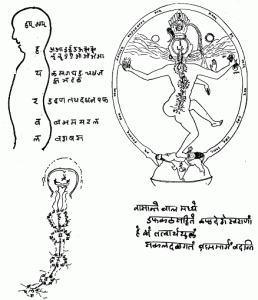
Veena can also be represented as the spinal cord and also the relation to the chakras. The Vedic representation of the human spinal cord as the musical instrument (Veena) . The 24 frets of the instrument are analogous to the 24 cartilages in the spinal cord. The number 24 also relates to the 24 syllables in the Vedic Gayatri mantra. Thus the inter-relation between a temple, Goddess Saraswati holding Veena, The production of seed-sounds at the various chakras in the spinal cord and representation of Veena as spinal cord shows the multi-faceted manifestations of Vedic principles and experiences.
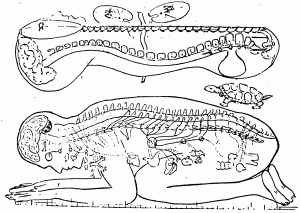
The spiritualistic and mythological approach of Veena
The Hindu goddess of knowledge and wisdom, Saraswathi plays the veena. The Hindu epic, Ramayana has a reference to the celestial being Saint Narada singing the praises of Vishnu while playing the veena. It is also a Hindu belief that Narada was the one who brought music to the Earth. The Vedas mention the instrument veena. According to the history, the Vedic veena had five parts, the siras or the head, the udara or the bowl, the ambhana or the sounding board of the belly, the tantra or the string and the vadana or the plectrum [2]. There is also the story about one of the Hindu trinity Siva, the god of destruction created veena upon seeing his wife Parvathi sleeping with her hand across her breasts, hence the shape of the veena with two globular parts and the finger- board in between. The Hindu philosophy reflects on the metaphysical understanding of Man in relation to the Supreme power, that is jeevatma, the individual to paramatma, and the Universal principal[3]. The veena has four main strings to play the melody and three side strings to provide the drone. Because they are pulled frequently to play the melody the four main strings go out of tune while the side strings pretty much stay in tune because they are only strummed and there by used as reference in re-tuning the main strings. This can be compared to the Hindu philosophical concept of the individual or the jeevatma strayed by the Karmic actions, the paratma remaining changeless.
Importance of Veena
वीणा वादन तत्वज्ञः, श्रुति जाति विशारदः।
तालज्ञश्चाप्रयासेन, मोक्ष मार्गं नियच्छति।।
“Veena vadhana tathvangna sruti, jathi, visartha talanjaaprayasena moksha margam niyachathi”
– Yajnavalkya in his ‘smriti’ (literature about music)
( the who is well versed in veena, one who has the knowledge of srutis (subtle quartertones and microtones) and one who is adept in tala – all of them attain moksham or salvation without effort.)
Veena festivals
- Maargashira Veena Festival – since 2004 organized by Sri Guruguha Vaageyya Pratishtana Trust & Sri Guruguha Sangeeta Mahavidyala.
- Mudhra Veenotsav – since 2005 at Chennai
- Veena Navarathri – since 2007 at Chennai organized by the Veena foundation and the Indira Gandhi National Centre for the Arts
- International Veena conference and festival – since 2009 by Sri Annamacharya Project of North America (SAPNA)
Notable vainikas
Pioneers and legends
Epic personalities such as Ravana, the lord of Lanka, royalty such as the mighty Vijayanagara emperor Sri Krishnadeva Raya and emperor Achyutadeva Raya, sage Sri Raghavendra Swami and great Carnatic music composers such as Sri Muthuswami Dikshithar were ardent practitioners of the Veena. The particular Veena used by emperor Achyuta Raya was known as ‘Achyutabhoopali Veena’. The Veena used by Sri Muthswami Dikshitar was unique for it’s upturned ‘Yali’ face. The veena used by Narada is called mahati.
- Muthuswami Dikshitar
- Veenai Dhanammal (known for her individual style)
- Veena Sheshanna (Mysore style)
- Veena Subbanna (Mysore style)
- Veena Venkatagiriappa
- Veena Doraiswamy Iyengar (Mysore style)
- Emani Sankara Sastry (Andhra style)
- Chitti Babu (Andhra style)
- Karaikudi Sambasiva Iyer (Karaikudi style)
- Karaikudi Subbarama Iyer (Karaikudi style)
- K. S. Narayanaswamy (Travancore style)
- Trivandrum R Venkataraman (Travancore style)
- S Balachander (known for his individual style)
Other exponents
- Ranganayaki Rajagopalan (Karaikudi style)
- Vainika Praveena R.S Keshava Murthy
- Rajeshwari Padmanabhan (Karaikudi style)
- Veena R Pitchumani Iyer
- Vasa Krishnamurthy
- Manchala Jagannadha Rao
- B.Sivakumar
- B.Ananda Rajyalakshmi
- Kalpakam Swaminathan
- K.Rajalakshmi
- Kaza Subhashini Sastry
- Paleti Hemalakshmi
- Ravinuthala Padma Chakravarthy
- Srikantham Nagalakshmi
- Sujana Vadlamani
- Karukurichi A. Balaji
- Vijay Venkateshwar Inala
- N.Anantha Narayanan
- Mudikondan S.N.Ramesh
- Mangalam Muthuswamy
- Sivanandam and Sarada Sivanandam (Thanjavur style)
- R.K. Suryanarayana (Mysore style)
- Sangameswara Sastri (Andhra style)
- Veena Venkatramana Das (Andhra style)
- Kalyanakrishna Bhagavatar (Travancore style)
Contemporary artists
- Padmavathy Ananthagopalan – Chennai based, disciple of Lalgudi Gopala Iyer, creator of a portable veena, advocate of gurukula tradition and founder of Sri Satguru Sangita Vidyalaya music school.
- Rugmini Gopalakrishnan – Thirvananthapuram based, disciple of K. S. Narayanaswamy.
- Jayanthi Kumaresh – Bangalore based, disciple of Padmavathy Ananthagopalan, recognized with Kalamamani Award, founder of Indian National Orchestra.
- D. Balakrishna (Mysore style) – Bangalore based, son and disciple of Doraiswamy Iyengar, recognized with Ganakashree and Karnatala Kalashree awards.
- Suma Sudhindra – Bangalore based, disciple of Chitti Babu, recognized with Rajyotsava & Kalaimamani awards, creator of Tarangini veena, carnatic-jazz exponent.
- Nirmala Rajasekar – disciple of Kalpakam Swaminathan, recognized with McKnight Performing Artists Fellowship and founder of Naada Rasa music school.
- E. Gayathri – Chennai based, disciple of Kamala Aswathama and T. M. Thyagarajan, recognized with “Kalaimamani” and “Sangeet Natak Akademi” awards, Vice Chancellor of Tamil Nadu Music and Fine Arts University.
- D Srinivas – Hyderabad based, disciple of Srinivasan and P. Srinivasa Gopalan, recognized with “Ugadi Visishta Puraskaram” Award, “Ashtana Vidwan” of Shri Kanchi Kamakoti Peetham.
- Jaysri-Jeyaraaj – Chennai based artists, disciples of A. Anantharama Iyer and A. Champakavalli, recognized with “Nadha Kala Vipanchee” Award, founders of Veenavaadhini school.
- Rajhesh Vaidhya – Chennai based, recognized with Kalaimani award, founder of Ravna International School of Veena, has worked with various music directors of Tamil movies.
- Revathy Krishna – Chennai based, disciple of Sundaram Iyer, and later with Sharada Shivanandam and K.P.Sivanandam; recognized with Kalaimanani and Kumar Gandharwa Awards, also now for film recordings.
- Punya Srinivas – disciple of Kamala Aswathama and Suguna Varadachari, member of Panchachanyam band, over 5000 film recordings to her credit.
- Prince Rama Varma – disciple of Trivandrum R Venkataraman and K. S. Narayanaswamy, organiser of Swathi Sangeethotsavam and member of the Travancore royal family.
- R. Parthasarathy
- Saraswati Rajagopalan – Dehi based, disciple of K S Narayanaswamy, T.S. Raghavan and Radhamani Sharma; and member of Veena Foundation.
- Bonala Sankaraprakash
- Iyer brothers – Melbourne based, disciples of R. Pichumani and R. Venkataraman, recognized with the Multicultural Award for Excellence by the State of Victoria.
- B Kannan – Chennai based, disciple of Vasantha Krishnamurthy and Pichumani Iyer, Founder-President of Youth Association for Classical Music (YACM) and composer of many thillanas.
- Suvir Misra – Delhi based civil services officer proficient in Rudra veena, Saraswati veena and the Surbahar; inventor of the Misr Veena, known for playing Khayal in the Saraswati Veena.
- Prashanth Iyengar – Bangalore based, disciple of Padmasini Narasimhachar & R.K. Suryanarayana, composer of 90 varnas (including 72-varnas tuned in each of the 72-melakarta ragas), holder of the limca record for a 24 hour marathon veena concert.
- Srivani Yalla – Tirupati based, “A” graded AIR artist, Head of S.V.College of Music & Dance.
- Mr. TR Sambasivam disciple of smt Ranganayaki Rajagopalan follows karaikudi style. A great exponant and he works as a lecturer in Tamil nadu govt music college chennai . He is also an isaikaimamani awardee.
References in ancient texts and literature
The Ramayana, the Bhagavata and Puranas all contain references to the Veena, as well as the Sutra and the Aranyaka. The Vedic sage Yajnavalkya speaks of the greatness of the Veena in the following verse: “One who is skilled in Veena play, one who is an expert in the varieties of srutis (quarter tones) and one who is proficient in tala attain salvation without effort.”
Many references to the veena are made in old Sanskrit and Tamil literature, and musical compositions. Examples include poet Kalidasa’s epic Sanskrit poem Kumarasambhava, as well as “veena venu mridanga vAdhya rasikAm” in Meenakshi Pancharathnam, “mAsil veeNaiyum mAlai madhiyamum” Thevaram by Appar.
Each physical portion of the veena is said to be the seat in which subtle aspects of various gods and goddesses reside in Hinduism. The instrument’s neck is Shiva, the strings constitute his consort, Parvati. The bridge is Lakshmi, the secondary gourd is Brahma, the dragon head Vishnu. And upon the resonating body is Saraswati. “Thus, the veena is the abode of divinity and the source of all happiness.”- R. Rangaramanuja Ayyangar
Religious associations within Hinduism
The patron Hindu Goddess of learning and the arts, Saraswati, is often depicted seated upon a swan playing a veena. Lord Shiva is also depicted playing or holding a vina in His form called “Vinadhara,” which means “bearer of the vina.” Also, the great Hindu sageNarada was known as a veena maestro. and refers to 19 different kinds of Veena in Sangita Makarandha. Ravana, the antagonist of the Ramayana, who is also a great scholar, a capable ruler and a devoted follower of Shiva, was also a versatile veena player.Scholars hold that as Saraswati was goddess of learning, the most evolved string instrument in a given age was placed in her hands by contemporary artistes.
Playing technique
It is said that it is not enough if one merely knows to play the veena, he should also know the secrets of the instrument and how it responds to a devoted votary.
The photo of Veenai Dhanammal more accurately illustrates how the veena is held than the more fanciful Ravi Varma painting.
The Vina is held with the resonator to the player’s right and the surakkai on the left thigh. The right hand forefinger and middle finger gently pluck the strings while the little finger, in upward strokes, strike the three Tala strings, vibrating in unison and chiming with a regular beat. While the right hand produces the sound (Nada), the left hand, which comes under the Dandi to allow the fingers to rest on the frets, is used to manipulate this sound into notes or swarasthanas. The evocation of all the subtleties and nuances of the music rest primarily on the technique of the left-hand fingers. They may be placed simply between two frets for a ringing, unadorned note or can glide from note to note, or execute little jumps to land lightly on another fret or for oscillation of notes. In Vina, oscillation of notes is achieved by pulling the strings away, while remaining at the same fret to produce notes in succession, leading to what is known as sanchara. Its main attraction is the mellow tonal quality which is capable of evoking a meditative atmosphere.
n our examination, we find to our dismay this antique instrument is no match for other melodic instruments in its capacity to reach out to large audiences in concert halls. Fitting of the contact mike to the instrument results in distortion of its unique sound. This hoary art is an exacting mistress and it takes years to master the instrument. The instrument also poses problems in transportation with its long size. Tuning the instrument is also a job, not to speak of problems in its maintenance.
